Yankees final farm report: The summer is ending but not the harvest

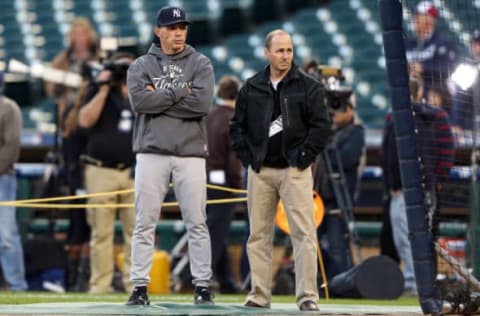
The Yankees farm teams have almost finished their work in the fields. It’s been a delightfully tumultuous summer for the farm, and here’s YanksGoYard’s last full look.
The Yankees Brian Cashman once had a vision, that to rebuild the Yankees through smart trades and young talent. Working slowly at first, his plan went into high gear last year at the trade deadline. Since then, the organization has changed greatly as players were added, subtracted, promoted or injured.
And in 2017, the Yankees began to harvest the fruits of Brian Cashman’s labor. Remember that Aaron Judge was considered more of a project who might still start the year in Scranton. Judge might not be the MVP, but he’s still the Are oh Why.
Gary Sanchez has established himself as one of the best throwing catchers in the game, and its most feared power hitting backstop. Tyler Wade has looked over-matched, but it has been opposing pitchers who have often seemed in over their heads against Clint Frazier and Tyler Austin.
And Jordan Montgomery went through several minor league levels this year, before he started going through AL teams. It is even fair to include Cy Young candidate Luis Severino on this list as he looked lost last year, and just as likely to return to Triple-A.
These young Yanks have indeed multiplied Yankees Nation, and increased its gladness. But it beggars the question, what’s left? Are there still great players to come, or just players? The 2017 harvest has been plentiful, but are the farm workers now few?
A Flood of Players
The answer is both positive and surprising: There might be as many great players still coming as have come up this year. That’s quite a shocking statement—I should know as I just typed it and am now shocked by it—but it is true none the less.
So, to help make sense of what is left, is my own prospect compilation.
While I read other lists and rankings during my research, I was not a slave to any other formats or evaluations. And I ranked almost every player of note without thought of numerical constraint.
I did not include any player who is currently on the Yankees, or is clearly a part of the big league club. Had I, I would have listed, as the Yankees best prospects: Aaron Hicks, Didi Gregorius, Starlin Castro and Matt Holliday. That also means players such as Caleb Smith were omitted.

Method Man
I used several key factors to varying degrees. History is important since baseball is all about longevity. If a player has not been in the system long, his previous experience (such as college) was taken into consideration.
Absent that, a player would have to be performing at a very high level to make this list in so short a time. And a player’s age at his level was usually a factor, although more so with position players. A body changes a lot from 19 to 25 and older players often dominate based on age.
And the age at which a player debuts is often an indicator of greater talent.
For instance, Mike Trout debuted one month shy of his 20th birthday. Derek Jeter became a regular at 22. Chase Headley, on the other hand, became a part-time player at 24 but did not get 600 AB’s until his 25th year. That is not meant as a slight, just a comparison to more talented players.
Judge is an excellent outlier, but age at each level remains one useful tool. I was also careful to take into account what first-hand scouts are saying. Reading numbers and watching video only go so far.
And I gave a lot of points if a pitcher is a starter. Relievers are incredibly valuable, but starters are more rare. Severino would have been a dominant closer, but the Yankees have three or four of those. As a starter, he is leading his team to the playoffs.
But the two most important questions were: What is the upside of this player, and how likely is it he has a long Yankees career? With all of that in mind, here are the awkwardly-numbered 38 Best Prospects Still Growing Down on the Farm.
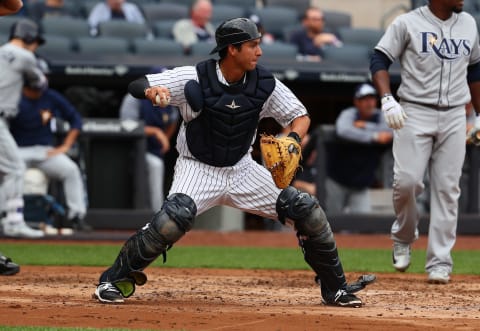
They Who Are Last Shall be First
We start at the bottom and finish with number one. But even before that, here are those who made honorable mention. These are players whose stats can catch your eye but fail to meet one too many criteria.
For instance, Kyle Higashioka is 27; he might go on to play in the majors but he has hit his ceiling as a prospect. The same it true for Zach Zehner, who is 25 and at Trenton; Sharif Othman is 28. At that age, it doesn’t matter what league you are in.
Ryan Lidge has not played enough, Brayan Jimenez was bad last season, and Donny Sands has had a good second half but still has no power. Wilkerman Garcia has talent but has yet to show it. Dom Thompson-Williams was the toughest call. He ended as unworthy to be ranked but remains a person of interest.
Now on to those still young enough and talented enough to one day wear pinstripes.
(38) LF Dario Unda: Age 21/ Team Pulaski
2017 AVG/OBP/SLG: .300/.358/.540
Unda is is getting too old to be at Pulaski and still be a prospect. He has shown some power, swatting 5 home runs in only 88 AB’s, but he is 21. Unda has a great track record, and a really cool name, but if he doesn’t begin to move up in a real hurry, I will never get to buy a jersey with his name on it.
(37) 3B Jose Polonia: 21/Staten Island
.223/.302/.223
Polonia is similar to Unda, perhaps a subconscious ranking. He’s been pretty consistent with his bat and has done his best at his highest level, where he also has his most AB’s. But he is 21 and it took him 94 AB’s to hit three homers.
His last ten might show he is going from good to very good: .306 with eleven hits. And it better be. If Polonia does not move up quickly next year, he will cease to be a real prospect.
(36) C Gustavo Campero: 19/Gulf Coast League
.304/.444/.545
Age at each level plays a larger role in the depths of the minors because the players have so few at bats. Because of that both here and with other players, I will often look at the last ten games. Ten games is often 20 or 25 percent of a young player’s season and can be a mark that he is starting to figure it out.
It can also just be ten good games. Predicting players is more an art than a science and we all make mistakes. I hope you remember that when you get ready to disagree with me in the comments section.
And age played a larger role in the rankings of the players in this group. For instance, Gustavo has a similar average (.304 in 112 AB’s) to the next player on the list but is one year older. Even with some additional power, that was good enough for Campero to come in at number 36.
Campero has put up three home runs in those 112 at-bats, two coming in his last ten games. That might not seem like much but remember Carlos Vidal has one home run and he’s two years older. Power plays, and even flashes of it in small sample sizes is worthy of notice.
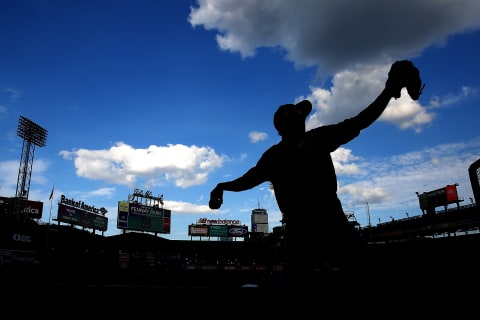
(35) RF Jhon Moronta: 18/GCL
.288/.357/.379
Jhon is hitting .297/.374/.370 at the GCL this year but has played only 48 games. Still, his age and BA over his last ten (.341) make his a promising start.
(34) LF Frederick Cuevas: 19/Pulaski
.286/.343/.444
Freddy has two things going for him. First, he’s slashing .304/.359/.475 in his 118 AB’s this year. And he has 3 home runs and eleven doubles in that short span. Second, he is only 19 and at Pulaski. But he is below Carlos Vidal because he has had only those 118 AB’s. Promising, but too inexperienced to get really excited about.
(33) P Albert Abreu: 21/Rehab assignment GCL
2017 AVG/WHIP/SO/WALK: 3.55/1.20/53/15
Abreu has to be the first big surprise on this list. But he has been injured for much of the year, tossing only 42 innings to date. While he has looked good—1 earned run in the four innings since his return—all he has shown is that he can be injured.
And he is pitching to vastly inferior competition right now. He keeps a spot on the list but there is nothing new to say.
(32) CF Carlos Vidal: 21/Charleston
.304/.363/.374
Vidal continues to hit…for no power. His average/OBP for the season are .304/.363 but he has just one home run and thirteen doubles. There is still a chance that he develops power naturally, but it seems less likely to be one Carlos’ tools.
(31) UI Oswaldo Cabrera: 18/Charleston
.246/.305/.322
Oswaldo plays all over the diamond. While that makes it more likely he one day plays at the big league level, it devalues him as a prospect. However, being a mere 18 and all the way at Low-A is impressive. Clearly the Yankees see something.
Digression
Just the fact that the 31st ranked player has an outside shot of making the team shows how deep the Yankees system is. Prospects rarely become players, so if even one of the above mentioned manages to become an every day regular, it would be an extraordinary boon for the team.
For most teams, in fact, having any potential players deep in their farm systems would be unique. The Yankees seem to have that potential deep into their system. Again, the majority of the Yankees minor league players will never make the majors. But the ones that do will come from this list. Here’s 30-26.

(30) SS Danienger Perez: 20/Staten Island
.250/.315/.339
Danny has had an up and down season and he’s hard to get a read on. But he’s shown flashes of consistency–hitting .326 with Pulaski with a home run–and can play his position. His ceiling is as an utility infielder but he probably needs to do more next year to maintain any kind of ranking.
(29) RP Nestor Cortes: 22/Scranton Wilkes/Barre
2.16/1.03/85/28
With Nestor we come to the first prospect guaranteed to contribute this year. His slow and measured rise is another example of the almost dichotic thinking the Yankees have on pitchers.
Baseball is about making adjustments and the Yankees are leading a new movement in pitching. Organizations have for years made throwing hard their main focus. Pitchers at all levels are asked to throw as hard as they can, as often as possible.
Hitters responded in kind and now routinely hunt fastballs. Many players take extreme uppercuts with a home run or bust, three true outcomes, approach. The Yankees, and a few other teams, have adjusted. Joe Girardi and Larry Rothschild have asked their pitchers to throw more off-speed stuff in order to neutralize hitters, with some success.
But they have been slow to embrace their own controlling pitchers. Chance Adams started the season as the Yankees best minor league pitcher and has maintained that status to date. Yet he has watched as a parade of lesser prospects premiered in pinstripes. Why? Partially because the Yankees are afraid his mostly off-speed arsenal will get destroyed.
Exploring Cortes
Cortes is in the same situation. Every year since 2014, Nestor has posted a sub-2.30 ERA. Last year was his best, moving across four levels, ending with a collective 1.53 ERA in 106 innings pitched. And, like Adams, he has gotten better as he has faced better competition.
In 31.1 IP at Triple-A, Nestor has given up only 21 hits but struck out 37. And since he has walked only seven men, his ERA is 1.44 and his WHIP is 0.89. But he, too, watched as even other Double-A pitchers were called up before him.
The Yankees are scared of soft throwers, although they want their pitchers to throw softer stuff.
Do you know how Hollywood casts a role for an unattractive woman? They find a beautiful woman and make her less attractive; think Ugly Betty. The Yankees are doing the same thing. They want pitchers to excel at throwing breaking stuff, but refuse to believe in those with the most natural talents to do so.
But by September first, it will be a moot point. Cortes is sure to be called up and given a chance to perform for Joe and Larry. I just hope Chance is, too. The only reason he is not higher on this list is that he is a reliever.
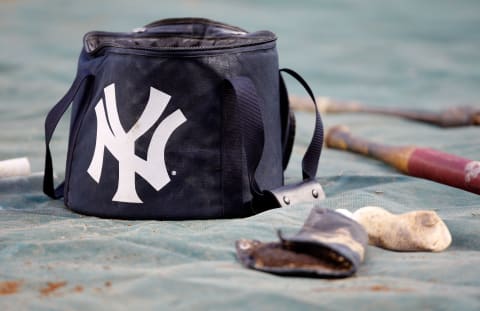
(28) RP Nick Rumbelow: 25/SWB
1.25/0.81/40/11
Close behind our first pitcher sure to be seen in 2017 is our second, Rumbelow. Nick was signed in 2013 and looked like a fast rising flamethrower, his strikeouts high and his ERA low. And by 2015 he went from prospect to pinstripes.
The problem was he was pitching injured and didn’t tell anyone, as I suspect from the information. That led him to have the worst year of his career, until the following one. Nick’s 2015 injury turned out to require Tommy John and he missed all but one inning of the 2016 season.
Rumbelow’s return has seen his resurgence. Since the first of June, Nick has pitched to a 1.29 ERA. He has 38 SO in his 35 innings, but only eighteen hits and ten walks (0.80 WHIP). He, too, will be called up in a couple of weeks. But his will be more of a promise fulfilled than an experiment entertained.
(27) SP Domingo German: 25/SWB
2.94/1.13/107/29
Similar to Rumbelow, German was once on the fast track to the majors until he needed major surgery. Domingo was signed, perhaps on a Sunday, by the Marlins and began professional play in 2010.
He came over in the Nathan Eovaldi deal after a breakout 2014: 123 innings pitched with a 2.48 ERA, and SO/BB ratio of 113/25. Then came the injury. Domingo missed 2015 and pitched but ten innings last year. This season, German has not only pitched his way to Scranton, but also the Bronx.
German has had a great year, getting better as the season goes along. He threw his first 33 innings for Trenton and posted a flat 3.00 ERA with 32 hits and 38 SO/10 BB. Promising after a nearly two-year layoff, even with a 1.27 WHIP.
German Pinzer
That was good enough for a call to the Bronx. Seemingly inspired, German returned to Scranton where he gave up only 50 hits and posted a 2.91 ERA in his next 65 innings. His WHIP also went down (1.06), while he maintained a better than three-to-one strikeout to walk ratio (69/19).
Which brings us to the likely return of Domingo number one.
German will be back in the bullpen no later than September. He might even get a spot start. But next year looks to tell the rest of his story. He will either become one of seven or eight starters used throughout the 2018 campaign, show that he is a bullpen arm only, prove injury prone, or be used in a trade.
Just before going to press, Domingo had another great start at Scranton. While that might have moved him up slighlty, I still believe German belongs in this range, comments be damned.
(26) SP Taylor Widener: 22/Tampa
3.57/1.16/121/48
If he were younger, German would be much higher on this list, and it’s why he is surpassed by Widener.
Taylor was drafted in 2016 out of South Carolina and the Yankees are not sure what they have. He was used as reliever last year but starter in 2017. His somewhat gooberish picture belies his serious abilities: 25 games and 113 innings pitched this year with only 83 hits.
Notable is that he has 121 SO and 48 Walks in those innings, to go with a 1.16 WHIP. Widener has good numbers but he does not pitch deep into games. He gets a lot of whiffs, but is 22 and only at Tampa. He looks on track to be a good reliever some day but he will need to learn quickly or his time to develop will evaporate.
The talent and potential of the prospects only increases as we move into the last half of the twenties.
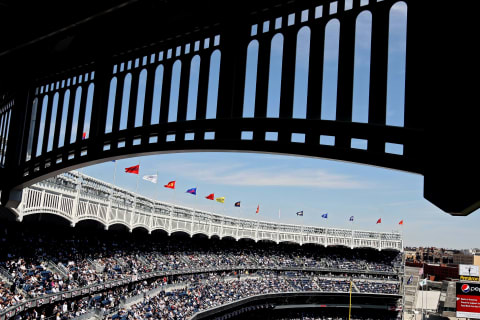
(25) CF Pablo Olivares: 19/Charleston
.273/.382/.364
Olivares is another player who benefits from his age and history. Signed in 2015, Pablo has improved every year in the system. He hit .267 two years ago in the DSL and .285 last year in the GCL.
Moved up again to Pulaski to start this year, Olivares again responded. The young center fielder put up the best slash of his career: .363/.495/.488.
Impressed, the Yankees moved Pablo up again this year and he has finally faced his first real obstacles. He has hit only .205/.281/.269 at Charleston, in the same number of games he played in Pulaski. That, however, is normal and Pablo is still on track to be at Scranton by the age of 23.
Rankings are subjective especially when you cannot see the players. The fact that the Yankees think enough of Olivares to move him up so young is telling. On the other hand, he is out of MLB’s Top 30 Yankees prospects. I took both into account when I ranked Mr. Olivares.
(24) 1B Chris Gittens: 23/Tampa
.269/.380/.457
Gittens will make you stare at your rankings for a long time. He’s old to be at High-A; his slash is less than impressive; and, he was injured this year. But he has that one important tool: Power. And power plays.
This year, in just 65 games, Chris has ten home runs and 12 doubles. And last year he hit 21 dingers with 23 doubles at the age of 22. He still needs to clean up his errors a bit—six this year—but a power hitting first baseman is always an asset.
I doubt he is ever a starter, but could provide the type of insurance the Yankees wish they had had earlier this year. If Gittens stays in the system, he will at the least get to ride the Scranton Shuttle someday and might some day hit a huge pinch hit home run.
(23) CF Canaan Smith: 18/GCL
.293/.435/.433
Drafted just this year, Smith came in with comparisons to Barry Bonds; that has continued. And it’s because Canaan has an excellent eye, helping him walk an inordinate number of times. It also helps Smith barrel up the balls that are in the strike zone.
In his 44 games, Smith has added two home runs and nine doubles to his impressive slash. And in his last ten, which is one-fourth of his season so far, he is hitting .472 and drawn nine walks. Canaan will be the next nineteen-year old assigned to Charleston.
His few games in the system have put him here at 23. But Smith might move up quickly both through the system and these rankings.
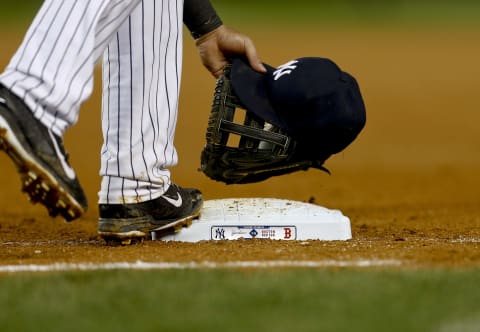
(22) 3B Dermis Garcia: 19/Charleston
.246/.362/.519
It would be very easy to switch Smith and Garcia. Dermis is a year older but has never had the overall hitting success as Canaan. He hit just .159 two years ago, and .206 last year in Pulaski. He returned to Pulaski and, after a slow start, slashed .270/.397/.565.
That’s okay, but not necessarily worthy of promotion. But Dermis might have more raw power than any prospect still in the organization; the only way a Yankees player could have more raw power than Judge is if Odin gives it to him.
Last year, at 18 years of age, Dermis had thirteen home runs and nine doubles in 194 AB’s. This year he has already duplicated the production with 14 fewer at bats. Of course his BA has taken a hit with his promotion, currently at .215 in just seventeen games, but he has hit .250 with three home runs and seven RBI’s in his last ten.
Dermis is still raw and has as good a chance as not making it as he does of being successful. But his potential, pedigree, and progression through the Yankees system place him relatively high on this list.
(21) OF Steven Sensley: 21/Charleston
.302/.381/.603
A 2017 New York Yankees draft pick, 12th round pick Sensley has surprised. He’s risen very fast, from the GCL, to Pulaski, to Charleston in just 46 games, yet still has a collective .310/.389/.626. Steven has also wrapped thirteen home runs this year to go with fifteen doubles.
Sensley has a past, just not in the minors. He hit 11 home runs at Louisiana-Lafayette last year, making his thirteen this year look like natural progression. Meanwhile, his advancement seems like natural selection: His one error for the season marks him as a survivor.
Steven spent this season making it to an age-appropriate level. That is an accomplishment not to be discounted. But we will have to wait until 2018 to find out if he is will survive and advance, or show his game incapable of evolving further.
(20) SP Trevor Stephan: 21/Staten Island
1.63/0.83/34/6
Yet another 2017 draftee, Stephan has both a good pedigree, and good stats for the 2017 season. Trevor pitched for the Arkansas Razorbacks last year, where he finished with the best ERA on the team (2.87). Better than that, his strikeouts were fourth in the SEC and his SO/BB ratio would be tops in any league (120/20).
Stephan has only pitched 27.2 innings for the Yankees this year but has done nothing to dampen their enthusiasm. That’s especially true as he has a 1.63 era and WHIP of 0.83. Add to that 17 hits and 34 strikeouts to just six walks, and Trevor Stephan begins to get more interesting.
It’s not unusual for the newly drafted to play below their age-appropriate level. And all Stephan has done is put himself in position to become a real prospect. But he is certainly more than young enough to rise quickly next year, if he’s good enough. And that’s good enough to land Trevor at number 20.
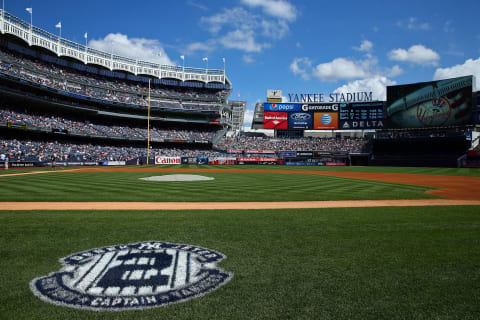
(19) SP Deivi Garcia: 18/Pulaski
2.73/0.95/77/15
Deivi (another cool name) may be 18 now, but he started this season as a 17-year old; his birthday’s in May. He was signed just two years ago and looked like a typical, long-term teenage prospect. But he seems to be ahead of the learning curve.
He hurled across three leagues this season, with just 33 hits in his collective 51.1 IP so far. But he is still trying to learn how to go deeper in games, as would be expected at 18; Chance Adams is 22 and still working on it. So it’s more than possible that Deivi is destined for the relief corp.
But as he put up 72 strikeouts in his 51 innings, but walked only 11 (0.86 WHIP), he looks to be ready for that role. My guess is that he moves up multiple levels again next year.
Deivi is absolutely not a sure thing. But it’s amazing how close he is to one, and we are only at number 19. Let’s move on.
Earlier this year I wrote on many of the Yankees best prospects in this article on the players drafted this year, or this one on the 2014 International Signing class, or even this one that served as a mid-season farm report. So, for many, this will be more of an update than an introduction, starting with…
(18) SP Glenn Otto: 21/Staten Island
1.17/0.72/25/3
The Yankees have shown a propensity for boom or bust players; Glenn Otto is one such player. Drafted in June, the signs so far point to Glenn becoming, “something remarkable”. In a scant six games and 12.1 IP, Otto has a 1.46 ERA with 8 hits and 21 strikeouts.
That puts Glenn on the 2018 fast track, skipping levels and missing bats. If he can keep up the pace, he could become the next Luis Severino. Or the next Nathan Eovaldi, or Manny Banuelos.
But at least the promise remains strong for this very talented pitcher, and his prospects rankings will soon reflect that.
(17) SP Juan De Paula: 19/Staten Island
3.06/1.13/37/20
Juan might not have as gaudy of numbers as Otto or Stephan, but he is two years younger and successful at the same level.
De Paula’s had a good season: 47 innings pitched with 33 hits and 37 strikeouts, a 3.06 ERA and 1.13 WHIP. Even better is that De Paula might be getting even better. He has given up only two runs in his last four starts, both in the same game, giving him three shutouts during that time.
And his last two starts have been his two longest, six and then seven innings, both shutouts.
But Juan will only pitch 60 innings or so this year. He has a lot to learn about pitching, and a long way to go before he proves he can pitch two hundred innings in a season. But fortunately he has plenty of time to get there.
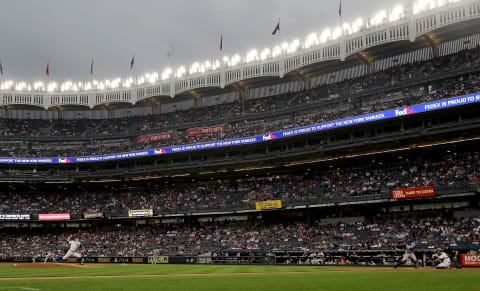
(16) RP Jose Mesa: 24/just promoted to Trenton
2.38/0.99/85/25
Mesa is both another sure September call-up and a player who appeared on my mid-season report. Since then, Mesa has continued to dominate in mostly relief duty, sporting a 2.38 ERA in his 68 IP; that goes with only 42 hits but 85 strikeouts. I’m not sure if Mesa will be a starter or reliever, but I am sure he will be a Yankees player.
(15) SP Brian Keller: 23/Tampa
3.07/1.12/145/25
I overlooked Keller in my earlier piece; he made sure no one overlooked him for the second half of the season. Keller has a 3.07 for the year but got better when he advanced from Charleston to Tampa. He lowered his ERA and WHIP (3.29/2.70) while his IP/SO/BB ratio increased: 82/90/17 at Charleston to 50/55/8 in Tampa.
Keller has one real edge over all the other pitchers anywhere on this list: he knows how to pitch deep into games. His four complete games lead not only the Yankees farm system, but all minor league pitchers in baseball.
And Brian has one more mark of distinction from the 2017 Yankees farm system: He pitched the best game of any Yankees prospect. In his complete game, two-hit shutout at the end of July, Keller struck out nine but walked only one.
That performance earned him Florida State League Pitcher of the Week honors and his inclusion here in the Yankees top 15. Were he younger or higher in the organization, he would also be more highly rated.
(14) 2B Thairo Estrada: 21/Trenton
.300/.349/.387
Thairo has a long track record of success in the Yankees organization and figures prominently in any listing of top Yankees prospects. He has at this moment 448 AB’s in 2017 and a .301 batting average, .349 in his last ten.
He has collected only 6 home runs and eighteen doubles this season, but is more than young enough to put up plenty of power for a second baseman. There is an outside chance he gets a September call-up, but a 100% chance he gets some time with the big club in 2018.
Not to say that he can win a starters job, but he will be invaluable depth at Triple-A. Thairo would probably project as the second baseman of the future for many clubs, and one of those teams might get their wish by the 2018 trading deadline.
(13) SP Rony Garcia: 19/Charleston
2.37/0.97/51/15
The great thing about Rony is that his whip and era have been consistently phenomenal. Rony’s thrown 58.2 inning so far, with a 2.45 ERA. His hits are good (46), while his strikeouts are respectable if not overwhelming (48). And because he has only issued fifteen walks, his 2017 WHIP is 1.04.
Rony’s even been getting into the seventh inning lately. Between his history and progress this year, Garcia is looking like a real sleeper.
The problem is his entire history is last year and this. Still, the Yankees have seen enough to have promoted him above other players and Rony looks ready to take another Baby Yankees step. Keller is a better pitcher right now but he’s four years older and only one level up.
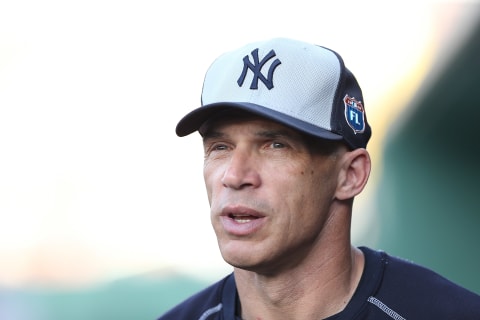
(12) OF Jake Cave: 24/SWB
.310/.354/.565
If Cave’s story is not known to you, then this is your first time reading about the Yankees farm system. Obviously, you did not take my advice and read those earlier articles.
Cave has put together a great season at Scranton, at any age: .313 with 19 home runs in 348 AB’s. The boy just keeps hitting and hitting and hitting some more. But Cave has two problems.
One is prospect fatigue, while the other is that he had been sub-par since his return from the Reds. Until this year. Cave has either finally fulfilled his potential or is having one great year.
He will get a chance to perform for Girardi and the rest of the Yankees coaching staff in September, and again in spring training. Cave could even win a starting job next spring if Clint Frazier stumbles out of the gate, although he seems more likely to serve as organizational depth.
As with any prospect who is blocked at the major league level, Cave is always on the trade market. But the Yankees might need him next year, and the rest of MLB will probably want to make sure 2017 was no fluke before parting with any significant assets for him.
But by then, he might just prove himself too valuable to trade.
(11) SP Freicer Perez: 21/Charleston
2.88/1.15/107/39
Perez highlights one of the weird things about ranking prospects. Every prospect should really be labeled either serious enough to get a try out with the Yankees, or not. Players can look like AL East division beaters all the way through Triple-A and still fail at the big league level.
So, all that organizations really care about is whether or not the player deserves a chance to be considered for a role. And I know Freicer Perez is in that category, right now. Every stat save one says so.
His ERA and WHIP are 3.01 and 1.19, respectively. He’s thrown 107.2 innings and given up but 89 hits while striking out 101.
Perez, though, is still trying to find length, a baseball observation and not an anatomical one: He has not gotten out of the fifth in his last six starts. Still, if he keeps going, he will one day find himself in Scranton packing for New York.
Life gets Weird Sometimes
What’s weird is where to rank him. Freicer is 21 and at Low-A, but pitchers often develop later than hitters. And some of the other pitchers on this list are younger with more talent.
On the other hand, his age and success make him more likely to work out than younger pitchers in the lower levels.
Does his history make him better than Brian Keller? Should being a starter make him more valuable than Jose Mesa? All that and more is what it means to truly try to evaluate talent.
I will leave it like this. As I type this, I have no idea where I will rank Perez before hitting, Publish. But wherever that ends up being, it will indicate that Freicer Perez is on track for his Yankees tryout.
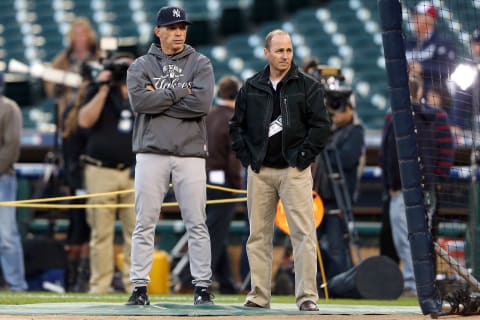
(10) 2B Nick Solak: 22/Trenton
.301/.390/.467
Like most of the players in the top fifteen, I wrote about Solak earlier this year. Nick was drafted in the second round last year, meaning he didn’t play much in 2016. But he brought a promising pedigree.
He was showing off his skills earlier this year at Tampa. I praised him for his work but was only cautiously optimistic due to the combination of his age and level. The minor leagues is about laddering up in competition until you either best them all, or one gets the best of you.
My concern was that Solak was only doing well at High-A due to his age.
Nick is a Verb
Solak was promoted soon after my mid-season report and looks to be the better man. He’s hitting .309/.360/.515 against superior competition, .333 in the last ten of his seventeen games at Double-A.
More significantly, Solak has managed to maintain his runs, hits, and home runs per at bat, while his doubles per have skyrocketed.
As the end of the season arrives more rapidly the longer it takes to finish this piece, Nick’s numbers look good on him. He has amassed 414 at-bats, 125 hits, 194 total bases, 23 doubles, and 12 home runs. Oh, and he’s stolen 14 bases and limited his strikeouts to 88.
The best part is that none of this is a surprise, more a continuation of the success he enjoyed at Louisville. He’s at the right level for his age and has a great pedigree. That makes Nick number ten on this list and someone to watch in Spring Training 2018.
(9) RF Billy McKinney: 22/SWB
.279/.346/.500
If Freicer Perez shows the difficulty of ranking the Yankees system, McKinney shows the depth of it. McKinney still seems like a streaky hitter, but he has spent his time with the Yankees with a lot more good streaks than bad.
Evidence of that is his .325 average—and ten home runs—in 154 AB’s at Scranton. That would be good enough for a call-up by most struggling teams.
But not in this system. McKinney will be called up in September for outfield depth and match-up at bats. That, and his performance next year in Spring Training, will show if he is ready to be the Yankees fourth outfielder already or needs another year to grow.
Billy has already done enough to get a long look at the major league level. That, however, will have to come with a different team. The outfielders in front of him are just more talented. And McKinney is too talented not to be used as a trade piece at some point, perhaps as early as this winter.
McKinney might get some important AB’s for the Yankees in a few weeks, and he is already penciled in as their fourth or fifth outfielder next season. At some point, he will likely become a valuable trade piece.
And all of that only gets him to ninth on this list; I can’t wait to see who’s ahead.
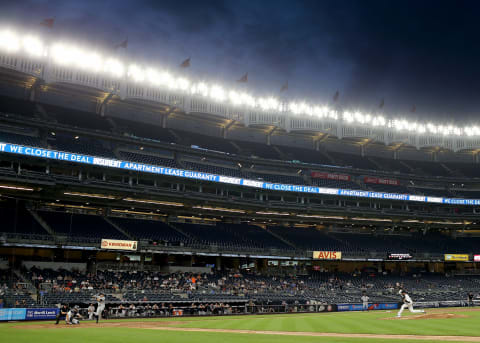
(8) SP Jorge Guzman: 21/Staten Island
2.03/1.01/78/16
His early season success and 105 MPH fastball showed promise by mid-season. Guzman has continued to fulfill his tantalizing potential and sits with a 2.03 ERA and a WHIP of 1.01 in his 51.2 IP. And of course Jorge has thrown 78 strikeouts in those fewer than 52 innings pitched.
Guzman has hopefully shown he has found consistency and will be a rapid riser next year, perhaps ala Jordan Montgomery. Unless he gets injured, Guzman will get a chance to show his heater next spring and again in September 2018. If he grows into a big league role before that, it will show a growth that might win the Yankees Best in Show.
(7) SP Domingo Acevedo: 23/Trenton
3.25/1.20/142/34
I am happily married and had to learn the hard way that I make many, many mistakes. That brings us to Domingo number two. Last month, in the heat of the trading deadline and the face of little improvement by Acevedo, I wrote that he was not likely to ever reach his potential.
Some readers took exception. They questioned how I could question Domingo’s future progress. Well, Acevedo must really like that guy because he seems to have turned a corner right after being defended.
Domingo has always been a hard thrower, which means he dominated the lower levels with one pitch. That meant he was always going to project at least as a quality reliever. But the dream, for both he and the Yankees, was as a starter.
Sunday Mornin’ Comin’ Down
But when Acevedo began this year by posting a 4.57 ERA at Tampa, and a similar 4.38 in his brief stint at Scranton, it looked that Acevedo was less likely to fulfill his potential than Sheffield or Tate. That no longer looks the case.
Domingo has now thrown 79.1 innings and put up a 2.38 ERA. His strikeouts are down but still exceptional (82), while his walks (17) and hits (65) show an under control pitcher. As in under control by the Yankees for a long time.
Acevedo will bring his strong right arm to the Yankees bullpen in September and to Scranton next year. He probably needs another full year in the minors but there is a strong possibility that Acevedo turns into a powerful front line pitcher.
If not, he will still contribute to the Yankees out of the bullpen for years to come.
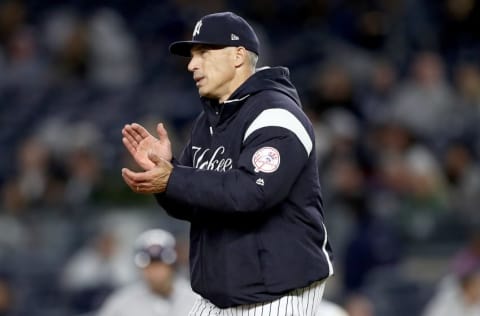
(6) SP Justus Sheffield: 21/Trenton
3.09/1.35/79/33
Sheff was another hard to rank player.
He only pitched sixteen games this season and is currently on the DL. However, when he did pitch, he showed a lot of promise. Justus gave opposing lineups no peace over his 90 IP. He gave up almost exactly one hit per inning (89) and struck out just under one per inning (79).
I wouldn’t necessarily have him quite this high but he has some intangibles. One is that he is a lefty. Again, I found some very valuable feedback in the comments section from my last article and took it to heart. Shef has to be overvalued because of his throwing arm.
And scouts and other prognosticators love his stuff. They have been wrong many, many times, but their opinions are still incredibly valuable. Finally, the Yankees saw fit to promote him to Double-A, another interesting indicator.
So, Sheffield stays at six at least until next year. But that will be the real prove it to the Yankees year. What’s his face already believes in him.
(5) SP Dillon Tate: 23/Trenton
3.07/1.17/51/20
Tate may be older than either Shef or Acevedo at the same level, but he’s also a better prospect. While he does not strike out as many as either player, his control is more advanced.
Tate’s numbers at Tampa—58 innings pitched, 48 hits, 46 strikeouts, 2.62 ERA, and WHIP of 1.08—are better than Acevedo’s when he was there.
Remember he was once called the best arm in his draft class. And, he seems to be learning how to pitch deep into games, getting into the seventh inning or later in five of his last ten games. That’s a skill that some pitchers never learn at any age.
Plus, he seems to pitch with a chip on his shoulder; he wouldn’t be the first athlete to find success through anger.
The Rangers seemed to derail his progress, but now Tate is back on track and destined to ride the Scranton shuttle next year. He projects as anywhere from a solid three to a dominating five.
But the reason he is higher on this list than some with more talent is that Tate is a better bet to fulfill his good potential than more talented players are to fulfilling their great ones.
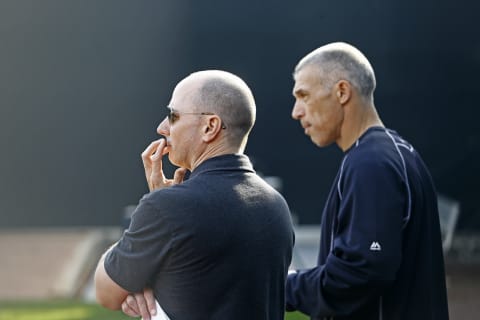
(4) SP Chance Adams: 23/SWB
2.27/1.03/127/53
Adams is both the fourth ranked prospect in the Yankees system, and the last in a string of five pitchers in a row.
Chance started the season as the Yankees best pitching prospect and will end the season as the same. He also ends the season as the best pitcher in the International League. But evaluating Adams seems as hard for the Yankees as it does for me.
His numbers mostly say front line ace: a 2.16 ERA in 133 IP and only 86 hits allowed. Adams strikeouts are acceptable if not gaudy (122) but his WHIP is excellent: 1.03.
Adams has a command issue, though; it’s why he has gotten into the seventh only once in the last ten games. Length is an important component to starting pitching, even in the age of the bullpen.
Nonetheless, Adams will get a chance to show what he can do in the Arizona Fall League and in next year’s spring training.
Adams’ Family
The great news about Adams is that it is almost impossible for him not to provide major dividends. He might prove to be unable to go deep into games and become a very good five. Or he might put it all together and be a front-line stud.
But even if neither of those comes to pass, there will still be (National League) teams willing to trade somewhat valuable pieces for hm, taking a chance they can fix Adams and find an ace.
So, Adams has the real potential to be a true One. And that only makes him fourth on this list. Now on to the Big Three.
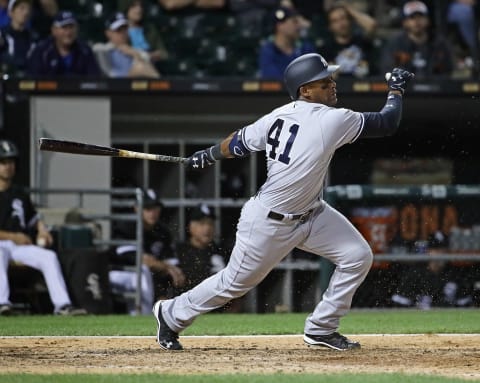
(3) 3B Miguel Andujar: 22/SWB
.320/.357/.508
What is there left to say about Andujar? He’s conquered every level by hitting for both average and power. Miguel has gotten 178 AB’s at Scranton and is currently hitting .326/.371/.528. And his season totals from both Trenton and Scranton are astounding.
Combined, Andujar has 137 hits in 431 at-bats, to go with his 15 home runs and 35 doubles. He has the best third-baseman’s arm anywhere on the farm and his defense has improved because of his great work ethic.
He still has work to do, but his improvement is noticeable and indicative of an even better future.
And now he is getting the recognition he deserves. I think if every player in the Yankees system was ranked on performance only over the last five years, Andujar would be their top prospect. He is a future player in the MLB, and possibly a star.
Miguel will be up in September to slowly take the job from Headley; he moves back as soon as Bird returns. He will return in the spring with the job ostensibly his, if he earns it. But no matter when Andujar arrives, he is the Yankees top-hitting third baseman of the near and distant future.
In most organizations, Adams or Andujar would be the top prospect. After all, both are big league players to one extent or another, and Miguel could be a star. But the Yankees still have two players with even greater P (potential).
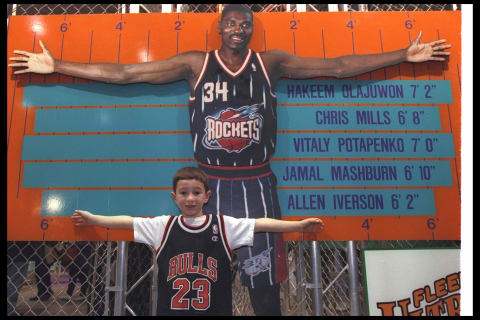
(2) CF Estevan Florial: 19/Tampa
.298/.374/.476
Estevan Florial is the Hakeem Olajuwon of the Yankees farm system.
The Dream did not pick up a basketball until he was seventeen. At 18, he was unnoticed and unrecruited; he only got a tryout with the University of Houston because of a family friend. By 19, he was barely good enough to be a redshirt freshman, playing sparingly.
But by the time he was 22, he was the best center in college and a top-three recruit. Hakeem went on to have a Hall of Fame career and even Shaquille O’Neil called him the best center in the NBA.
Florial is, hopefully, on a similar path. He did not start playing until he was a teen and entered the Yankees system extremely raw; raw but talented. Scouts and coaches could see Florial would have to become a baseball player before he could become a great baseball player.
Estevan was sent to Charleston at 19, as have a few others on this list. The difference is that Florial performed so well that he was selected as one of only two Yankees in the entire system to be selected for the 2017 Futures Game (D. Acevedo).
Or Was it a McFlurry?
Immediately after the trading deadline, in a flurry of promotions, Estevan was sent to High-A. And he showed that only Florial can limit Florial. Against better competition, and still at age nineteen, Estevan has hit Double-A running, whereas other players regress.
He’s only had 49 at-bats, but still he’s hitting .306/.386/.429 with 15 hits including a double, triple, and home run. That has all added up to 21 total bases to go with his seven walks, eight RBI’s, and five stolen bases. That’s called filling all the columns in a hurry.
For the season, he is hitting .298 with 117 hits and 12 home runs. And all at nineteen years old.
The Yankees showed they ranked him number one among their top outfield prospects not already playing in the Bronx by trading both Rutherford and Fowler. That seemed a flare to the baseball world and Florial’s profile has risen exponentially.
The Old AFL
It is doubtful Estevan is called up this year. But he is just right to go to the Arizona Fall League, where he will most likely become the fourth Yankees player in four years to win the MVP. The Yankees will get a look at him in the spring, before he returns to Tampa.
The 2018 Yankees, however, will get a chance to see him. No later than next September, Florial will get his big league tryout. My guess is he no worse than the Yankees fourth outfielder by 2019, at the advanced age of 21.
He would easily be the most talented player in this or most systems if it weren’t for Gleyber Torres.
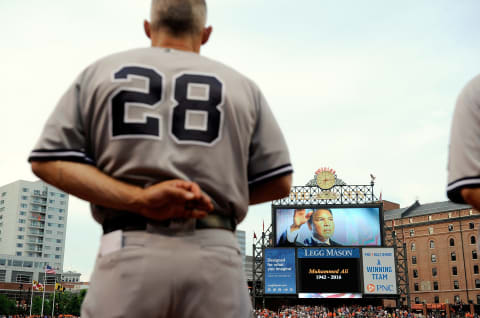
(1) SS Gleyber Torres: 20/SWB
.287/.383/.480
Twelve months ago, Gleyber was 19 and had just been promoted to High-A Myrtle Beach; Torres was then in the Cubs system. Since that day, things both seen and unseen have confirmed his mercurial talent.
First, he was the prize piece in a trade with the Yankees and was sent to Tampa for the final 39 games of the season. Impressed, the team sent him to the AFL, where he became the youngest player ever to win the MVP award.
He got a long look in spring training, but had taken his last look at Single-A. Instead, after just those 39 games in 2016, Gleyber started the 2017 season at Trenton, and soon after was sent to Scranton.
More from Yanks Go Yard
- Predicting Yankees-Diamondbacks LF trade package after Ken Rosenthal update
- Yankees add to championship core with Wilmer Difo signing
- Aaron Judge’s ‘breadcrumbs’ showed he was never leaving Yankees, has more moves in mind
- Creating a Yankees-Bryan Reynolds trade package after latest Pirates update
- Yankees analyst Cameron Maybin projects surprise landing spot for Gary Sánchez
But even after a bevy of whirlwind promotions, Torres arrived at the highest level ready to play his best ball.
Gleyber, and his last of the really cool names on this list, hit .309/.406/.457 in his 81 AB’s. His 25 hits included four doubles, a triple, and two home runs to go with thirteen walks. He also drove in sixteen RBI’s while collecting 37 total bases.
Torres is the number three prospect in all of baseball, a true shortstop, and has already been compared to a young Miguel Cabrera, by the man who managed him when he was young Miguel Cabrera.
With the injuries to Didi and Starlin this year, the only reason Gleyber has not made his MLB debut is his non-career threatening Tommy John surgery.
Imagine a world where Gleyber did not need surgery. That means he would have gone from Single-A to the bigs in fewer than twelve months…at the age of 20. Yoan Moncada is listed as the top prospect in baseball; he’s 22.
When Sam Jackson Quotes from the Bible you Think’s it’s Cool
Gleyber will come into spring training given every chance to win an infield job. If there are any delays, they will last only as long as Gleyber’s first big hot streak at Scranton.
But no matter how it happens, when the Yankees call up Torres, they might just add their most talented player, including those currently on the team.
The 2017 New York Yankees have gathered the first ripe fruits from their bountiful farm. But they have not yet reaped to the very corners of their fields nor gathered the full gleanings of the harvest.
Next: Bird Returns to Help Girardi and the Yankees Fly
That must wait until next year, when the team is likely to add as many as six of their top ten prospects from the farm, including those who will come up later in the season. That will do two things.
One, it will serve to complete the vision Brian Cashman had when he first started building a championship club.
And, more importantly, it will make next year’s First Farm Report much shorter.